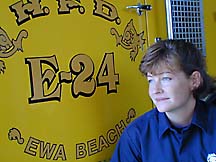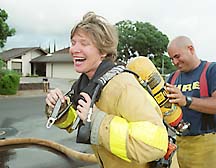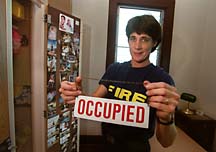


Wahine firefighters:
‘Can handle’
The five women members
By Jaymes K. Song
of the Honolulu Fire Department
have earned the men's respect
Star-BulletinWhen the Honolulu Fire Department hired its first female firefighter in 1987, a complaint was soon filed with the mayor's office after a Manoa resident saw a firefighter struggling to pull a hose at a house fire.
The angry resident wanted to know why the department was hiring 19-year-old women who couldn't do the job.
It turned out the department's only woman firefighter wasn't on duty that day.
The person struggling with the hose was a man.
Twelve years later, firefighter Debbi Akiona shrugs off the incident.
"I don't know why he thought it was me," said the 31-year-old Akiona. "I guess the (firefighter) must have been small."
But she still gets questions about why a woman is doing what had been a man's job.
"It doesn't upset me," she said. "I keep a pretty good attitude. But if I'm having a bad day, it irritates me."

A common question: "What do you do at the fire station?""I do the secretarial work, and I'm the cook," Akiona usually replies with a smile. "And they don't know if they should believe me or not."
There are currently five female Honolulu firefighters, less than half of 1 percent of HFD's 1,100 firefighters.
Nationwide, 5,000 women firefighters make up about 2 percent of the 265,000 total firefighters, according to a national women's firefighters association.
Honolulu Fire Chief Attilio Leonardi said he wants more women firefighters, but few complete the training.
In the last Honolulu firefighter entrance examination, 94 women were among the 3,000 applicants who took the test. Twelve women were among the 565 applicants who passed and were put on a waiting list for training. But only one woman entered the training academy, and she dropped out on the first day.
A lot of women, as well as a lot of men, don't pass the rigorous physical testing, Leonardi said.
The test includes climbing a 70-foot ladder, doing a one-mile run in 8 minutes and completing a 100-meter swim.
The most difficult part seems to be The Relay.

While wearing firefighter gear, the applicant must uncoil 200 feet of hose, run back; carry a 50-pound bundle of hose 200 feet, run back; drag a 175-pound bundle of fire hose 50 feet; and then drag a hose full of water into position, all in 2 minutes.The female firefighters said the physical testing, which is the same for both genders, does contribute to the shortage of women.
Akiona, a self-proclaimed "couch potato," said she trained for months to pass the physical test.
From her home in Waimanalo, Akiona would run up and down the Koolaus with a backpack full of weights to build strength.
She also took swim classes while attending the University of Hawaii.
"All I did was party in high school," said the '85 Kamehameha Schools graduate. "I had to totally change my life."
The other women were active hikers, swimmers or paddlers and said they had no problems with the test.
"The women, they handle," said Mililani fire Capt. John Robago.
But Robago and others admit they were leery when Akiona joined their ranks in 1987, the department's first female firefighter.
The biggest question was their physical strength, said Waialua fire Capt. Paul Noyes.
Firefighters say a lack of strength could mean not being able to open a fire hydrant, carry a victim or an injured fellow firefighter out of a burning house or handle a loaded fire hose.
Male firefighters also were leery about female co-workers at fire stations not equipped with separate restroom, bed and shower facilities.


"They (the men) thought they would have to change their routine, and they weren't comfortable with that," Noyes said.The attitudes, however, started changing when the women showed they could do the job, Noyes said.
"It was just a matter of getting them in the station," he said.
Still, some prejudices may remain, Noyes admitted.
"I guess there's still some old-timers that haven't changed their minds," Noyes said. "But they probably haven't worked with them either."
Although female volunteer firefighters have been battling blazes since the early 1800s, firefighting is still one of the last occupational frontiers for women on Oahu and nationwide.
None of the five women had childhood dreams of riding a big truck screaming down the street or putting out raging house fires.
Not even Akiona, who came from a family of Honolulu firefighters. Her father was a retired fire rescue captain, and four of her brothers are firefighters.
"I wasn't interested in this field, but my dad thought it would be good practice to take a civil-service exam, so I took it just for the hell of it," Akiona said.
"My oldest brother, Byron, said, 'You know, the department isn't a place for a lady,' " Akiona said.
But when the public and her friends found out she might become Honolulu's first female firefighter, she became more determined to complete the training.

"The eyes were on me," she said. "I can't go and goof around. People were laughing, even friends. I was a little upset."Stephanie Doi, a former free-lance photographer, came across the job while searching for a job for her boyfriend. She turned in an application just to see what would happen.
Debbie Wayman, the second woman to join, said firefighting was a natural extension of her previous job as a city lifeguard.
Ricci Naone has no regrets about giving up her job as a Hawaiian Airlines flight attendant to become a firefighter. "I still have nightmares about telling people to put away their bags overhead," she said. The fifth female firefighter, Jennifer Davis, joined after meeting Naone at a party and talking to her about firefighting.
Davis, a lifeguard in college, joined HFD to help people.
The women are better at comforting victims of fires, medical calls and car accidents, Robago said.
Victims are more relaxed with a female firefighter, he said, especially kids.
"Women are compassionate," Davis said. "Not that (the men) they're not compassionate. We just have a slightly feminine side."
Fire Capt. Robert Maladra of Pawaa said bringing in women to the station has made the men better firefighters as well.
"The other firefighters try a little harder because they don't want to be outdone by women," he said. "They're on their toes."
The five women said being around so many men is like having a lot of big brothers.
Men seem to be so much more easygoing, more laid back, compared with women, Akiona said.
"They sit down, shoot the breeze, have fun and laugh," she said.
She said she always got along better with men than with women.
Wayman said she gets teased just as much as the next guy. "If they don't tease you, they don't like you," she said. "It's being part of a family."
"I'm one of the group without being one of the guys," she said.

Firefighter Jeffery Richardson, who works with Davis, said everyone treats her the same, but "sometimes you can't help notice she's a girl."Like when the guys take showers, now they close the door.
"She does her work and she keeps up with the guys," Richardson said. "It's nothing significant. For me it's the same."
The men "have always been great," Davis said. "They are really supportive."
New fire stations are being equipped with lighted signs that alert others that a woman is in the shower or restroom. Dividers also are being installed between the beds for privacy.
In other stations, women are supposed to place a traffic cone or "occupied" sign in front of the door to tell others that she is in there.
But none of them really uses the signals. And none of them has experienced any problems.
"They wouldn't barge in on their sister, so they don't barge in on me," Wayman said.
Although the job is challenging, stressful, exhausting, emotionally draining and dangerous, the women say it is fulfilling and exciting.
"I absolutely love it," Davis said. "How many people can say they truly love their job?"
The women cannot imagine going back to a "normal" desk job, working 9 to 5.
"Staying home is my first choice," Wayman said. "Since I have to work, this is where I'd be happiest.
"You get sweaty, dirty and stinky," she said. "It's not glamorous, but it's sure a lot of fun."

Jennifer Davis
Age: 32
Home: Mililani
Stationed at: Ewa Beach
Sworn in: 1996
Previous employer: Worked for her father's small business repairing airplane radios
High school: Punahou
Hobbies: Paddling, scuba diving, triathlons
Personal: Married; no children

Ricci Naone
Age: 38
Home: Mililani
Stationed at: Mililani-Waipio
Sworn in: 1992
Previous employment: Hawaiian Airlines flight attendant
High school: Maryknoll
Hobbies: Running
Personal: Married to a fire captain; merged two families for a total of six children

Stephanie Doi
Age: 35
Home: Kailua
Stationed at: Pawaa
Sworn in: 1992
Previous employment: A free-lance photographer
High school: Roosevelt
Hobbies: Paddling and traveling
Personal: Single, former crew member of the Hokule'a

Debbie Wayman
Age: 40
Home: Waialua
Stationed at: Waialua
Sworn in: 1989
Previous employer: City lifeguard
High school: Campbell
Hobbies: Surfing
Personal: Married to another firefighter

Debbi Akiona
Age: 31
Home: Kailua
Stationed at: Kahaluu
Sworn in: 1987
Previous employment: College student
High school: Kamehameha
Hobbies: None; "Life's on hold," she said, since having baby
Personal: Grew up in Waimanalo the youngest of seven children